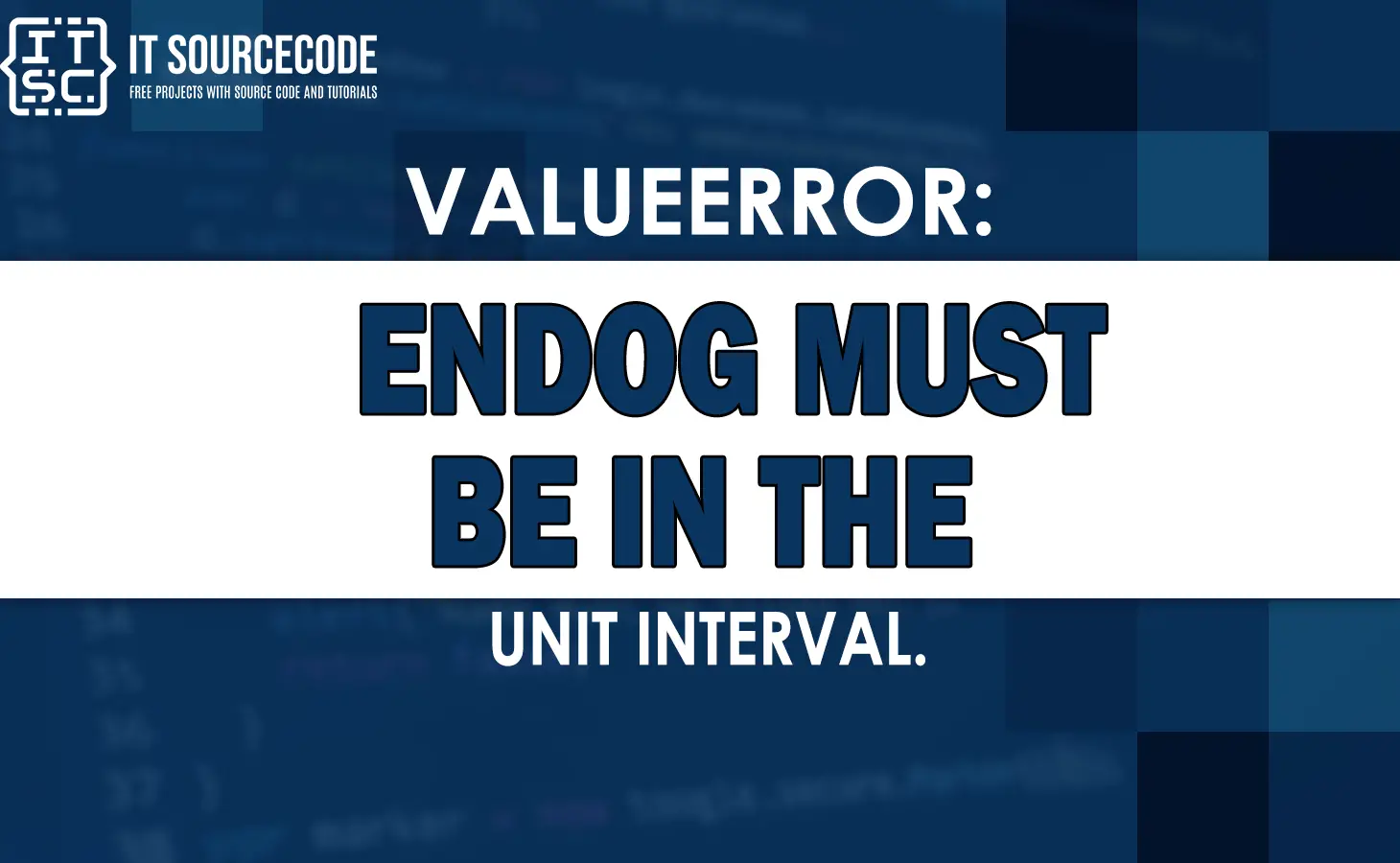When it comes to programming, value errors are inevitable. One of the common value errors that programmers often encounter is the ValueError: endog must be in the unit interval error.
This error message shows that the “interior” variable, which refers to the dependent variable in a statistical model, should be within the unit interval, which ranges from 0 to 1.
Understanding the ValueError endog must be in the unit interval
The ValueError endog must be in the unit interval error that typically occurs when we are working with statistical models or machine learning algorithms that need the dependent variable to be normalized between 0 and 1.
This error serves as an expression that the internal variable, such as probabilities or percentages, must decrease within this range for the model to function appropriately.
How the Error Reproduce?
Here’s an example of a ValueError with the message “endog must be in the unit interval“:
import numpy as np
import statsmodels.api as sm
# Generate some random data
endog_variable_example = np.random.normal(loc=0, scale=1, size=100)
exog_variable_example = np.random.normal(loc=0, scale=1, size=100)
# Fit a logistic regression model
model_example = sm.Logit(endog_variable_example, exog_variable_example)
example_result = model_example.fit()Output:
Traceback (most recent call last):
File “C:\Users\Dell\PycharmProjects\Python-Code-Example\main.py”, line 9, in
model_example = sm.Logit(endog_variabel_example, exog_variabel_example)
File “C:\Users\Dell\PycharmProjects\Python-Code-Example\venv\lib\site-packages\statsmodels\discrete\discrete_model.py”, line 479, in init
raise ValueError(“endog must be in the unit interval.”)
ValueError: endog must be in the unit interval.
In this example, we are attempting to fit a logistic regression model using the Logit class from the statsmodels library.
The endog_variable_example represents the response variable (also known as the dependent variable), and exog_variable_example represents the explanatory variable (also known as the independent variable).
How to Fix the Valueerror endog must be in the unit interval.?
Here are the following solutions and examples to solve the Valueerror: endog must be in the unit interval.
Solution 1: Converting endogenous variable to the unit interval
If you encounter the ValueError with the message “endog must be in the unit interval” error.
The first solution to solve the error is to ensure that your internal variable is within the unit interval.
Let’s take a look at an example where you have a dataset consisting of probabilities and you want to fit a logistic regression model using the statsmodels library in Python.
import numpy as np
import statsmodels.api as sm
# Assume you have a variable called 'probabilities' with values ranging from 0 to 1
endog_example_variable = np.array([0.2, 0.4, 0.6, 0.8, 1.0])
# Convert the probabilities to the unit interval
endog_normalized_sample = (endog_example_variable - np.min(endog_example_variable)) / (np.max(endog_example_variable) - np.min(endog_example_variable))
# Define your explanatory variables (independent variables)
value = np.array([[1, 2], [3, 4], [5, 6], [7, 8], [9, 10]])
# Fit the logistic regression model with the normalized endogenous variable
model_sample = sm.Logit(endog_normalized_sample, value)
example_result = model_sample.fit()
# Print the summary of the logistic regression model
print(example_result.summary())Output:
The code fits the logistic regression model using the normalized endogenous variable (endog_normalized_sample and the explanatory variables (value).
Then, it prints the summary of the logistic regression model using result.summary().
Solution 2: Checking the data range
In some scenarios, the ValueError may occur due to incorrect data values.
It’s important to check your data falsity within the expected range.
For example, if you are working with percentages, you need to double-check that all values are expressed as fractions between 0 and 1.
import numpy as np
import statsmodels.api as sm
# Assume you have a variable called 'percentages' with values ranging from 0 to 100
endog_value_example = np.array([20, 40, 60, 80, 100])
# Convert the percentages to the unit interval
endog_normalized_sample = endog_value_example / 100
# Define your explanatory variables (independent variables)
variable_example = np.array([[1, 2], [3, 4], [5, 6], [7, 8], [9, 10]])
# Fit the logistic regression model with the normalized endogenous variable
model_sample = sm.Logit(endog_normalized_sample, variable_example)
example_result = model_sample.fit()
# Print the summary of the logistic regression model
print(example_result.summary())Output:
By dividing the percentages by 100, we transform them into fractions within the unit interval, resolving the ValueError.
Solution 3: Rescaling the data
If your data is not within the unit interval, another solution to fix the error is to rescale the data.
Rescaling involves mapping the original range of values to the applicable range, in this case, 0 to 1.
Let’s have a look at an example using the sklearn library in Python.
import numpy as np
from sklearn.preprocessing import MinMaxScaler
# Assume you have a variable called 'data' with values ranging from 100 to 1000
endog_sample = np.array([200, 400, 600, 800, 1000]).reshape(-1, 1)
# Rescale the data to the unit interval
scaler_sample = MinMaxScaler(feature_range=(0, 1))
endog_normalized_result = scaler_sample.fit_transform(endog_sample)
print(endog_normalized_result)Output:
[[0. ]
[0.25]
[0.5 ]
[0.75]
[1. ]]By applying the MinMaxScaler to your data, you can map it to the fitting range of 0 to 1, and it resolve the ValueError.
Frequently Asked Questions
The word “endog” refers to the endogenous variable, which is the dependent variable in a statistical model.
In the context of the ValueError: endog must be in the unit interval, it specially shown that the dependent variable requires to be normalized within the range of 0 to 1.
Yes, there are different methods to normalize the endogenous variable. Besides the Min-Max scaling technique shown earlier, you can search other normalization techniques like Z-score normalization or decimal scaling based on the specific requirements of your data.
Conclusion
In this article, we discuss the causes of this error and provided example codes and solutions to help you to resolve it.
Remember to check and normalize your internal variable properly to ensure it relies on the unit interval.



